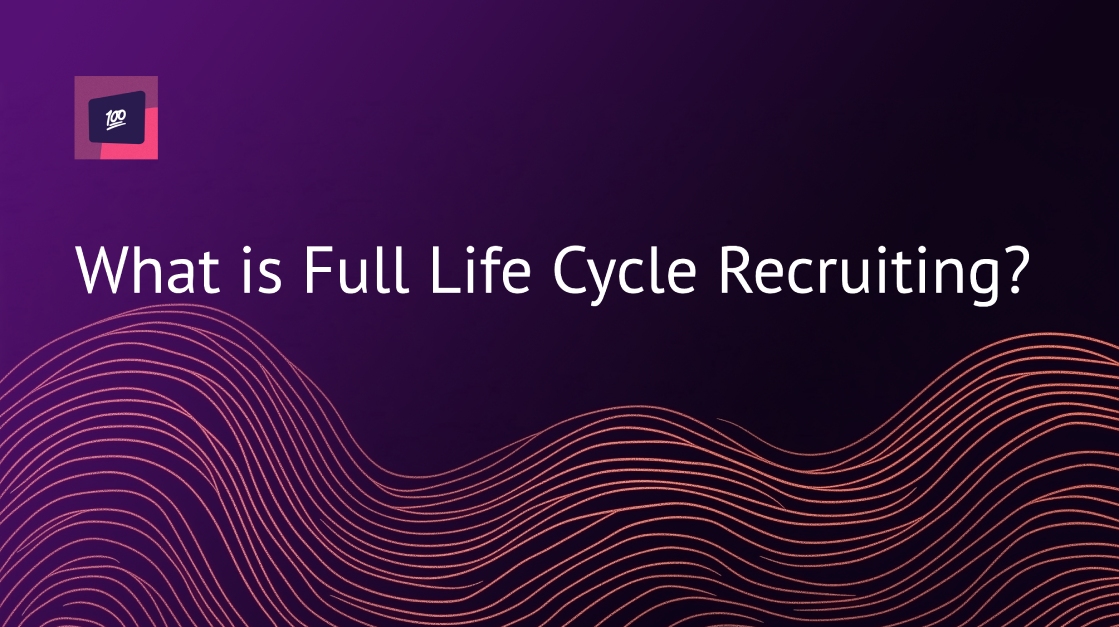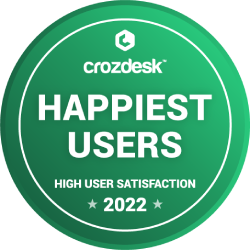What is Full Life Cycle Recruiting?

One might be surprised to learn how many stages and processes a simple act of filling an open position takes. No, it’s not just about posting a list of requirements on a career website and waiting for resumes to flood in.
Full life cycle recruiting involves a great number of complex processes and might take months. In fact, 52% of recruiters from various niches and industries say that their average time-to-hire is 3+ weeks long. Moreover, 18% say that a recruitment life cycle can sometimes span to a couple of months.
the best candidates faster



As a business owner, you might wonder what on earth would take so long to bring in a new qualified professional. A full cycle recruiter, on the other hand, knows exactly that finding a perfect candidate is next to impossible. But they manage to do it each time nonetheless. So, let’s find out what full-cycle recruiting is, what processes it covers, and why full life cycle recruiters are real heroes in disguise.
Table of contents:
What is full life cycle recruiting?
What are the full life cycle recruitment stages?
What does a full life cycle recruiter do?
Full life cycle recruiting tools
What is full life cycle recruiting?
Full life cycle recruiting is a comprehensive all-around approach to hiring new personnel. It covers the entire process from creating a job opening description to onboarding a new hire, and everything in between.
The notion is a god of many names. Some refer to it as just full cycle recruitment, while others use the terms ‘end-to-end recruitment’ or ‘360-degree recruitment’.
What are the full life cycle recruitment stages?
Regardless of what you call it, the full cycle recruiting process usually consists of the six key stages: preparing, sourcing, screening, interviewing, hiring, and onboarding. Each of them covers a huge number of huge and small tasks that HR reps do on a regular basis. So, let’s now talk about them in detail.
Preparing
On the preparing stage, full life cycle recruiters take care of everything they need to start actively searching for candidates. These processes are usually happening in close collaboration with managers and executives who should provide all the necessary information about their ideal candidate.
Once talent acquisition experts get a grasp on it, they start writing job descriptions where they list both required skills and the company’s perks. The latter is actually more important than one might think. Numerous reports have confirmed that 92% of people will consider a job offer from a company with an excellent reputation. At the same time, corporate benefits and perks are major factors in considering whether it is even worthwhile.
Quick tip:
HR specialists can save themselves a lot of time by repurposing millions of job descriptions that have been written already. For instance, 100Hires has created its resource of free templates for popular job descriptions. They contain all the most common requirements for each given job, so all you have to do is to add your company’s specifics. Any HR rep can download and use them for free.
Sourcing
“Candidate sourcing” is this fancy term recruiters use to describe the process of searching for eligible candidates to fill a job opening. While it sounds like something simple and unary, human resources experts consider it the hardest part of their job.
The sourcing stage starts with posting job descriptions on job board websites, social media as well as in different HR groups and communities. Once the word is out, people will start sending in their resumes and cover letters. But this will get recruiters only so far.
Career websites should take care of active candidates, while there are also passive ones. Passive job-seekers are people who are happily employed and not actively applying for new jobs. And they usually make up the majority.
End to end recruiting takes care of them as well. They are usually in charge of reaching out to qualified passive candidates and trying to interest them with a new job opening. If they manage to show them all the benefits and build some trust, people are more likely to reconsider.
Quick tip:
People are not always eager to disclose their email addresses, which is why sourcing candidates often require more guesswork than real research. In this case, HR professionals are trying to uncover some patterns that corporations are using for their employees’ email addresses: e.g. steve.jobs@apple.com, s.jobs@apple.com, steve@apple.com, etc.
One can generate as many possible combinations as possible with the help of the Email Permutator tool. After this, you can verify them in your Gmail account. Paste all the different email addresses into the ‘To’ field and click on them one by one. Gmail will show you the information about the candidate near their correct email address.
Screening
One by one, a database of suitable candidates will be taking shape. Now, the next step of full-cycle recruiting will require some thorough filtering. It’s up to talent acquisition experts to do some initial screening of job applicants and find out which ones are more suitable for the job.
They can narrow down their search by reviewing candidates’ resumes and portfolios and doing some basic background checks on social media. For what it’s worth, profiles on LinkedIn can tell a lot about peoples’ affiliations and connections in the business world.
After the basic checkup, HR representatives can proceed and schedule first intro calls with people who have met all the job requirements so far. These introductory interviews can give a general idea about candidates’ soft skills and help you understand their experience better.
Quick tip:
Companies can help recruiters speed up the whole screening process and make it more effective by applying a simple trick suggested by LinkedIn. In 2018, the company decided to change its approach to hiring. Among many other innovations, they cut down the number of core competencies for each open position. This allowed HR representatives to sharpen their focus and concentrate on the most important qualifications on the early stages of candidate screening.
Quote: To simplify, the Product executive team cut the seven core competencies down to four and made sure everyone was aligned on what they mean. These new competencies are:
Interviewing
With each new step of a full-cycle recruiting process, a list of candidates becomes shorter and shorter. By the time we get to the interviewing stage, it should contain only the best applicants. Now it is time to set up some real job interviews with managers and company executives where they can ask all the technical stuff.
After the interview, candidates can pass some test assignments that will show their skills in action. Both employees and recruiters can also resort to various psychometric tests, games, and role-play scenarios to measure candidates’ soft skills.
All this will give a 360-degree view of how good a candidate is at this job and social interactions.
Quick tip:
There are various approaches that companies use to evaluate their applicants. For instance, huge corporations including Google are strong believers in structured interviews. In a nutshell, a structured interview means asking all applicants the same interview questions and then grading them based on the exact same requirements. They allow businesses to evaluate job candidates with an unbiased eye and choose the candidate who scores equally good results in all categories.
After this, businesses can take advantage of evaluation forms that promote healthy calculated decisions. For instance the 100Hires applicant tracking solution has them built into every candidate’s profile.
All this will give a 360-degree view of how good a candidate is at this job and social interactions. After this, businesses can take advantage of evaluation forms that promote healthy calculated decisions. For instance, Google is a strong believer in structured interviews where managers ask all the same questions during each interview and then evaluate candidates based on the same qualification criteria.
Hiring
End to end recruiting implies that HR representatives are also responsible for the two final stages of the whole process — hiring and onboarding new employees. When all the evaluations are done and calculated, they can proceed to the pleasant part of their job. It’s time to compile a job offer and send it to the candidates that have successfully passed all the assignments.
It’s also a tricky one. People will negotiate for better terms, and it’s up to HR reps to act as middle people between companies and new hires during such negotiations.
At the end of the day, an offer letter should contain every piece of information and specific details about the job, salary, benefits as well as employment termination terms. If it’s well-written and clear, it can save everyone a lot of time in the future.
Quick tip:
At some points, companies like Microsoft and Amazon have incorporated the “bar raising” stage into their hiring process. The traditional understanding of a bar raiser implies that a skillful senior employee holds a final interview with a candidate and makes the final call in the hiring decision. This approach helps recruiters make sure that candidates will be able to keep up with the company’s values, requirements, and vision.
You can take this approach to the next level and hold such bar raising meetings with the whole team or corresponding departments. People who already work for you can be the best judges of your candidates’ teamwork and communication skills. So, it might be useful to trust their opinion.
Onboarding
Employee onboarding is a process of introducing a new hire to their job, office, other personnel and integrating them into all corporate processes seamlessly.
Why so much hassle, though? Well, this stage is pretty important for employee retention. If recruiters manage to get a new employee on board with the corporate culture and bring the team together, the chances of this employee’s sticking with the company increase drastically.
Quick tip:
As far as onboarding goes, recruiters can use every trick in the book — from official conferences to informal meetups, games, and corporate parties. Many known companies have come up with quite creative ways to make their onboarding programs notable.
For instance, Buffer assigns “three buddies” to each new hire who are always ready to jump in and help. Square takes it to the next level by arranging meetings with their CEO and casual 1-on-1’s with high-level executives.
What does a full life cycle recruiter do?
Depending on the size of a business, there are two kinds of full-cycle recruiters. On one hand, some people basically cover all of the above-mentioned stages on their own. Such HR representatives take on every single full life cycle recruiting task there are. This approach is more typical for small businesses that don’t have the capacity to hire a big department for recruiting.
Big corporations have adopted a different approach. They usually hire a huge HR department where designated recruiters are responsible for a narrow pool of tasks. Some of them are searching for candidates and screening them for the required skills. Others will take care of onboarding and retaining new employees long after they’ve been hired.
If I had to sum this up, a full life cycle recruiter or department should be in charge of the following assignments:
- Understanding and defining candidate personas for each job opening
- Creating job descriptions with corresponding requirements
- Publishing job openings on relevant resources (e.g company’s website, job search websites, social media communities)
- Sourcing eligible candidates
- Screening candidates by reviewing their applications, checking resumes and social media profiles, and disqualifying those who don’t match requirements
- Scheduling and conducting an introductory interview
- Scheduling interviews between candidates and managers
- Sending test assignments as well as keeping an eye on their completion and deadlines
- Acting as an intermediary between candidates and managers
- Sending job offers to those candidates who successfully passed all recruitment cycles
- Providing disqualified candidates with thorough feedback
- Onboarding a new hire
It is curious that 86% of recruiters report few or no qualified applicants for the positions they are trying to fill. The talent shortage is real. It takes up a huge chunk of full-cycle recruiters’ time to even source enough candidates in the first place. And they still have to take care of the rest.
Full life cycle recruiting tools
Don’t be intimidated by the amount of work, though. It does sound like a lot, but modern software solutions have allowed us to facilitate our work dramatically. And recruiting is no exception.
Source, screen, and interview all the best candidates with 100Hires. The tool offers a full set of features to cover the full life cycle of the recruitment process.
For instance, the pipeline view allows you to easily move candidates between various stages like Sourced, Phone screen, Interview, etc. Recruiters can keep all applicants in a convenient dashboard and divide them by job openings. The solution also has built-in evaluation forms that will make decisions easier on each involved side.
Sign up for 100Hires and adopt the structured approach to recruiting right away. The tool is free anyway.
the best candidates faster




